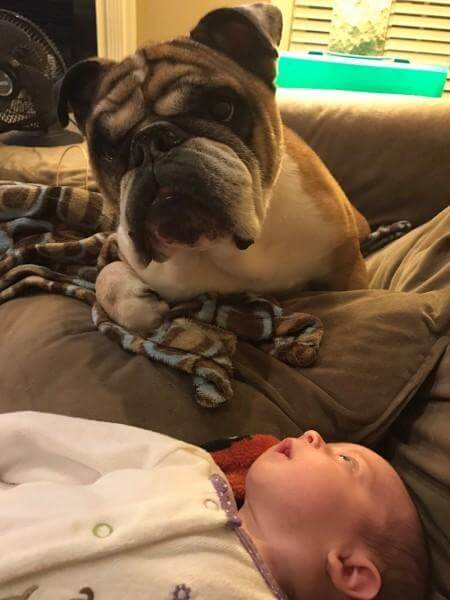
As a new mom, I have recently experienced the changes that your fur kids can undergo when being introduced to their new human sibling. Prior to the birth of Clara, I prepared the nursery, organized and put away all her new, tiny clothes, sterilized the baby bottles, struggled to get the car seat properly installed in the car, and even assembled her stroller, but there was one thing that I had not fully prepared my house and myself for, the changes that my dogs and cat would go experience as my first child came home.
The day we came home was a joyous one. We had been gone from our fur kids for almost a week and as we walked through the door our dogs were ecstatic to see us, dancing at our feet and happily trying to jump and lick our hands and faces. Then they noticed the car seat containing a tiny, 6 lb sleeping human. Luckily for me, the baby was asleep when we arrived home, and thankfully the commotion of our welcome home furry parade did not wake the baby. Each dog took a turn sniffing the baby and curiously investigating her little hands and feet while we sat next to the car seat on the floor. After a brief inspection, each dog decided that they would rather have belly rubs and promptly crawled in our laps, ignoring the new tiny human in our house. The cat was much less interested in meeting Clara, and she decided that it would be better to avoid the baby and watched the introductions cautiously from the top of the stairs.
An important thing to remember that not all animals are happy to meet the new addition and this transition should be approached slowly and patiently with constant supervision. It is not uncommon for this transition to be similar to introducing a new pet to the household. The existing pets can often become jealous, depressed, and sometimes even protective over their owners, so the number one thing to remember is your child’s safety. Never leave the new baby unattended within your pet’s reach!
In the beginning, newborns eat, sleep and poop, but engaging interactions with your pets are limited. Some pets quickly become bonded with the baby and will alert you anytime the baby seems fussy or is crying. However other pets will show less interest in the baby; occasionally sniffing and/or licking the baby, but otherwise seemingly ignoring the new addition. If your pet is showing anxiousness, aggression, or depression during this time then it is important to contact your regular veterinarian to discuss how to best handle this delicate transition.
During this time, remember that your pets need extra love and attention. If you want to take the baby for a walk then recruit some extra hands and take the dogs along, especially if they are used to getting daily walks. If your dog or cat is used to snuggling with you on the couch, then you may need to modify their positions, but try to not totally exclude them. Instead of being directly in your lap, teach them to lay next to you for belly rubs. Reward good behavior with yummy treats and warm words of encouragement. It is also important to set aside time for just you and your furry kids. When the baby is napping try to spend some one-on-one cuddle time with each of them or go play ball in the backyard so they know they are still an important part of the family.
As your baby grows and begins to change, there may be new concerns regarding your pet. When the baby is screaming, it can startle an anxious pet. Be sure to provide a safe place for your pet to go like their favorite crate or a special baby-free room. The baby will also start reaching for things and grabbing on to toys, hands, and pet fur. Some pets are tolerant of this behavior, but most are not too thrilled when the baby starts tugging on their fur. Early on, teach your child to be gentle and try to discourage pulling orbiting of the furry parts. And as mentioned before don’t leave your child unattended with your pets!
Finally, as your child becomes mobile, parents have so many things to worry about in their homes. In addition to the outlets, electrical cords, table corners, and the stairs, remember your pets may need some childproofing as well. As your toddler begins to walk, they will need support at first. Your pets should not be that support. Pulling up using the dog or cat will either anger the pet, make the pet fall on the baby, and/or cause them to walk away which could result in your child suddenly falling and injuring himself/herself. Once they are walking, toddlers are still unsteady on their feet so make sure to keep pets out of the way so that children don’t trip and injure themselves or your pets.
For any additional info in introducing your new baby to your existing pets, ask your veterinarian during your scheduled appointment. If you notice any signs that your pet is not adjusting well, such as aggression, hiding, resource guarding, or any other concerning the change in behavior then please contact your veterinarian so we can help your pet through this important transition.

